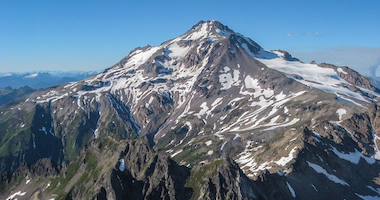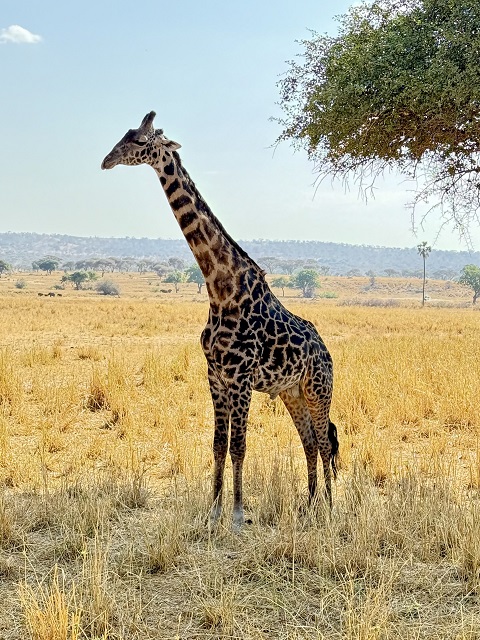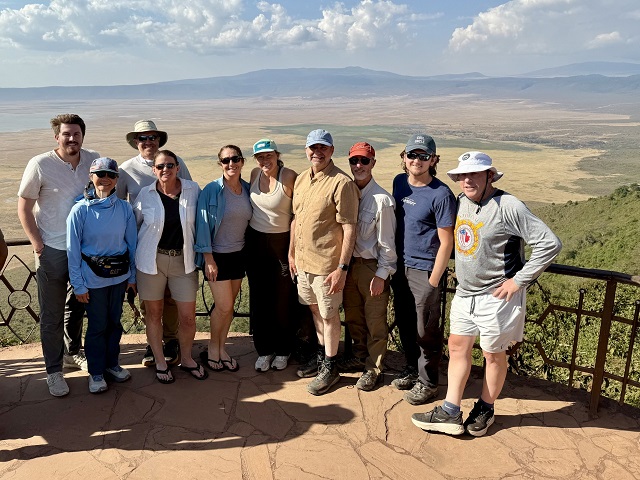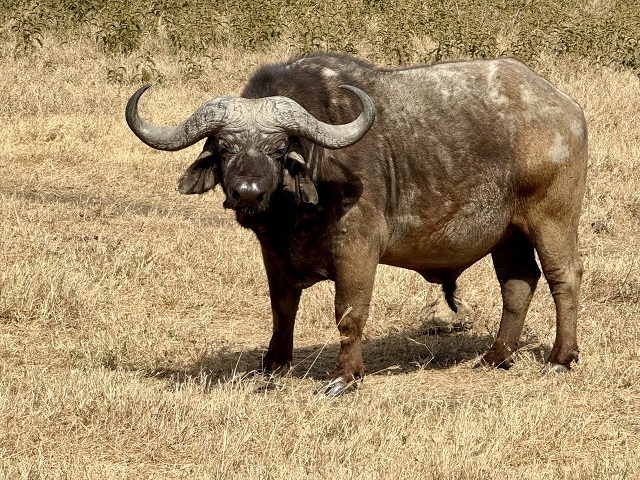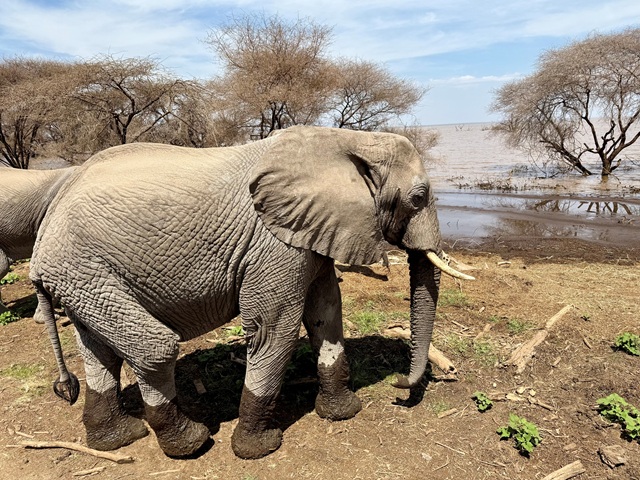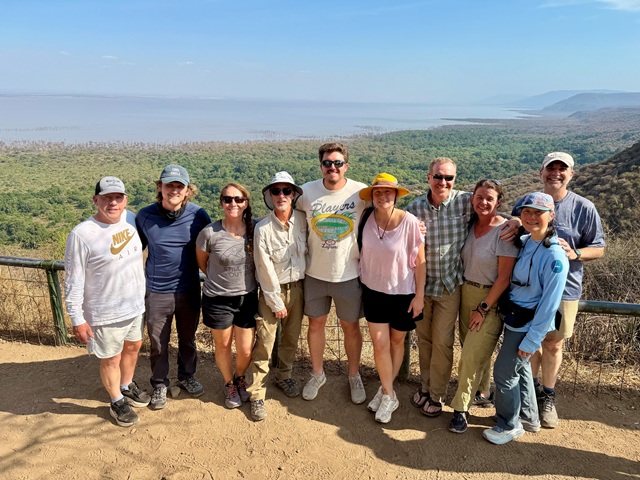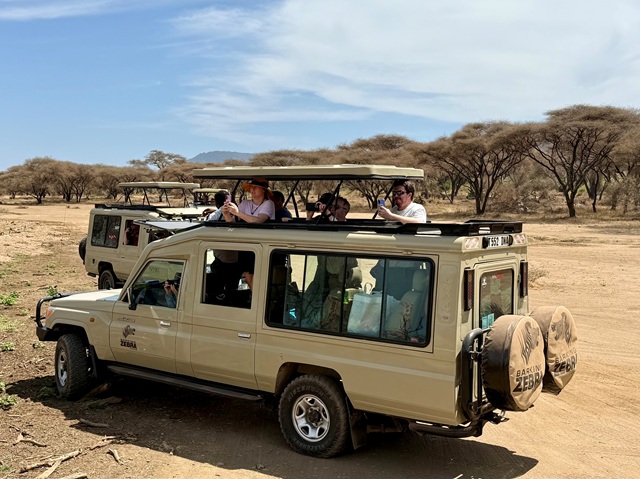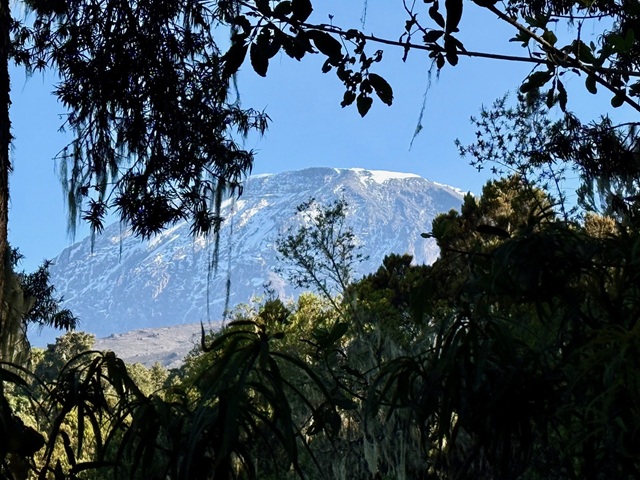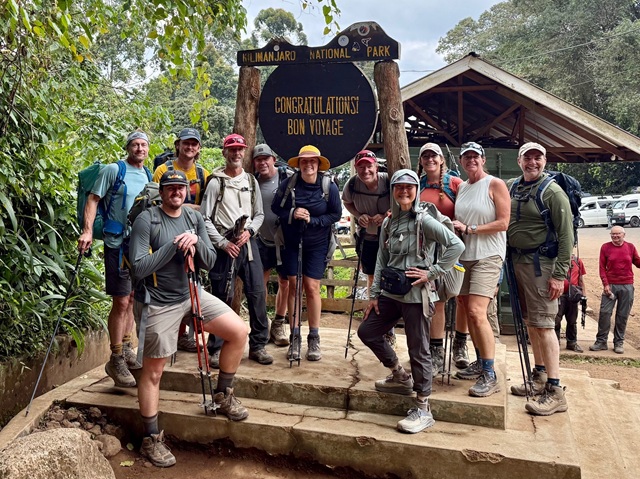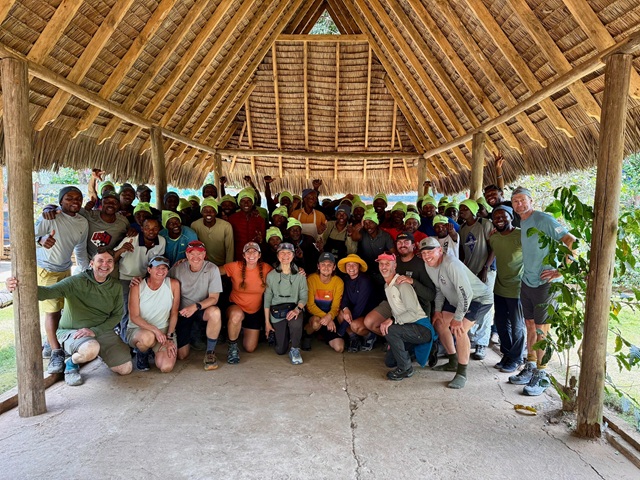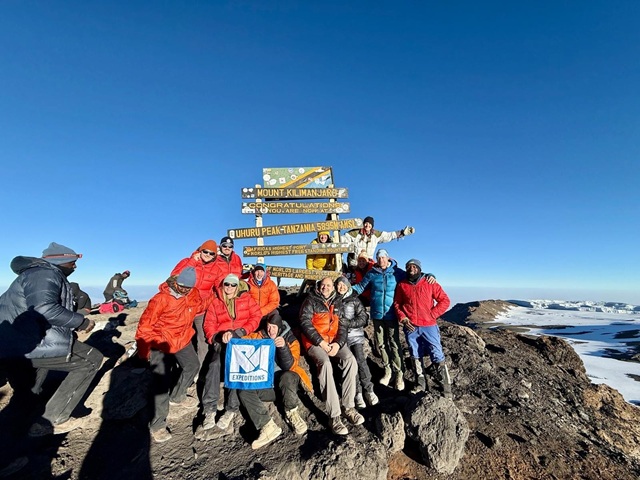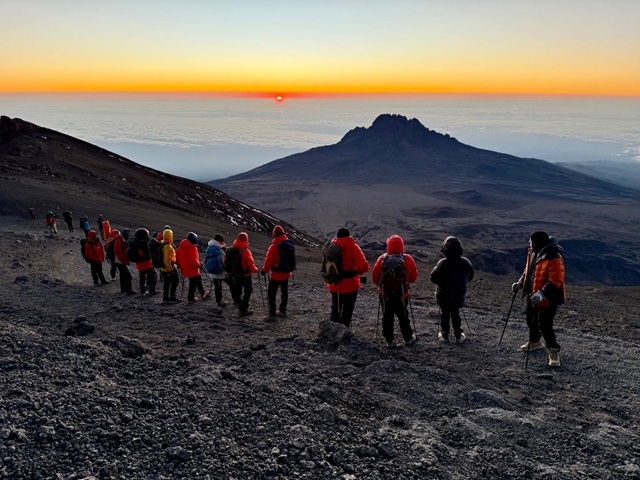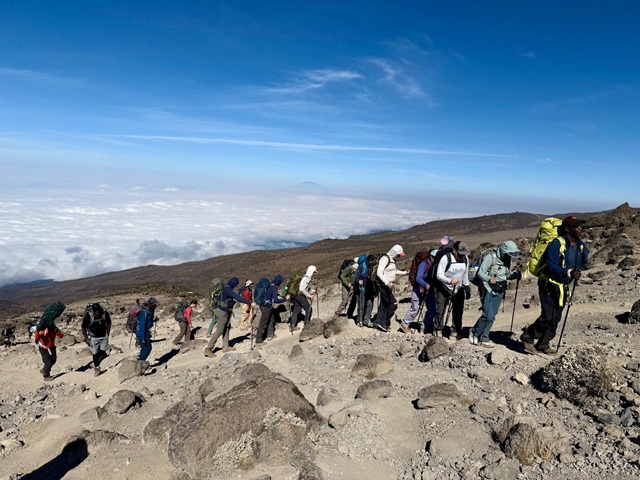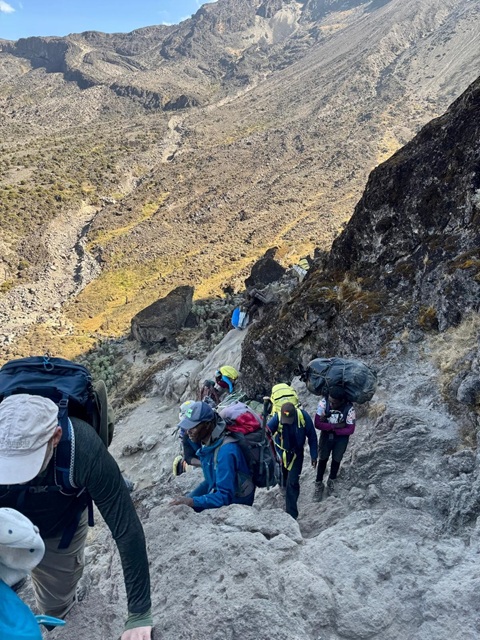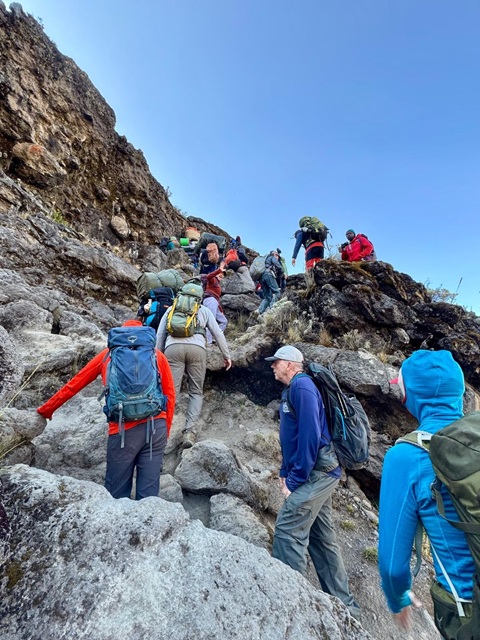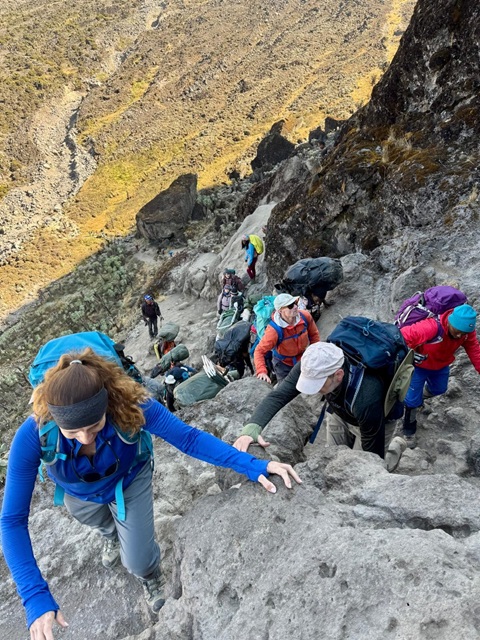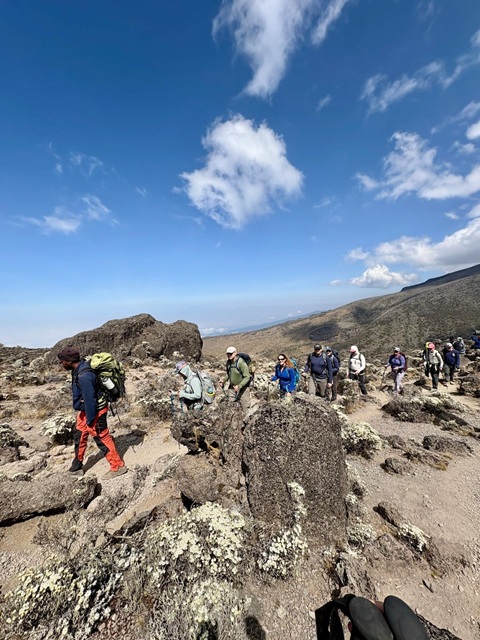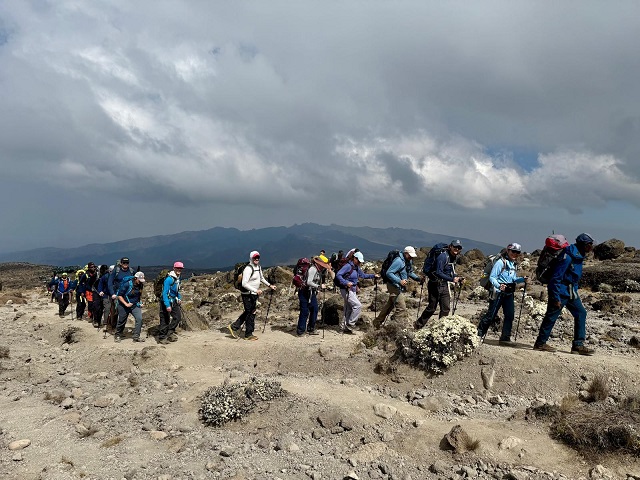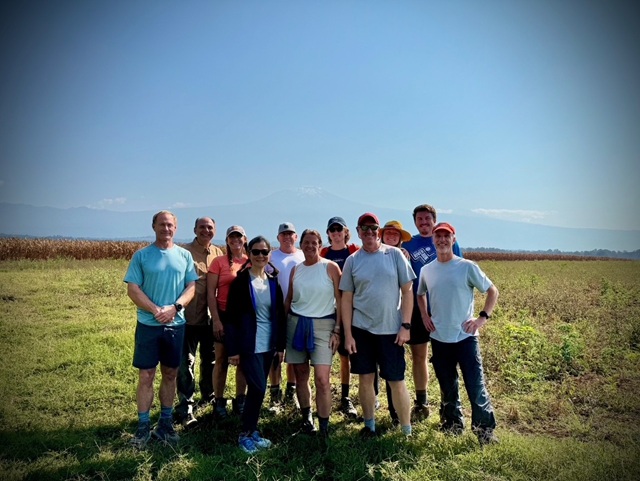Entries from Expedition Dispatches
Bueno dias from Ecuador. Yesterday our team reached the summit of (the nearly 20,000') Cotopaxi! When we awoke at midnight, it was snowing lightly. By the time we had breakfast and were ready to start climbing, the snow had let up; some clouds lingered, but stars were visible. The weather for our climb remained excellent: mostly clear skies, calm wind, and relatively mild temperatures. Our team stood on the summit at 7:15 a.m., and was treated to excellent views of the 20,700' Chimborazo, the Ilinizas, and the active volcanos, the Pinchinchas, which rise above Quito. After descending, we traveled out of Cotopaxi National Park to our current location of the hacienda La Cienega. This beautiful hacienda was built in the late 16th century, and has a rich and interesting history, including having housed the first volcanological study of Cotopaxi, and a European geographical expedition to measure the meridians.
We all enjoyed hot showers and a great dinner, before getting some much needed rest. Today we will travel north to our next hacienda, Guachala. We'll rest our legs today before starting our next climb, Cayambe. Tomorrow morning before heading to the climbers' hut on Cayambe, we'll visit the world famous market at Otovalo.
We'll keep you up-to-date with our whereabouts.
Posted by:
Categories: Expedition Dispatches Ecuador
Buenos dias from Ecuador.
Yesterday we traveled into Cotopaxi National Park; en route to the climbers' hut we were lucky enough to see six Andean Condors! They were very close to the road and were defintely an impressive sight, with wingspans of more than 6 feet.
Upon arrival at the end of the road, we shouldered our packs and hike 45 minutes to the climbers' hut on Cotopaxi. The rest of the day was spent resting, eating, drinking, playing cards, and telling stories ...the time spent here, at nearly 16,000' will help us get used to the (even)thinner air that awaits above.
This morning we are getting ready to head out to the glacier, in order to stretch our legs and review ice axe and crampon skills. The weather is very nice and we're looking forward to our summit attempt tonight. We will likely leave the hut around 1:00 am, and hopfully we'll be on top at 6 ot 7. We'll be in touch, and I'll send pictures when we have access to the internet in a couple of days.
Hasta luego
Saludos from the beautiful hacienda, Chilcabamba, at 11,500' on the flanks of Cotopaxi. The weather is great, and we have amazing views of our climbing destination, Cotopaxi from our bedroom windows.
We left the city behind today, and ventured south down the 'Avenue of Volcanos'. After an hour and a half of driving, we began our 2nd acclimitization hike. This time we climbed to around 15,400', to the climbers' hut at the saddle between the Ilinizas. This hike travels above treeline, through the rolling hill grassland known as the paramo. Good weather afforded us views of the expansive valleys below, but clouds kept the Ilinizas obscured from view. Everybody did great on this foray into thinner air. It looks like we've got a very strong team for our summit attempt, and the weather looks promising. But, you take it day by day in the mountains...
Tomorrow we'll head to the cliimbers' hut on Cotopaxi, at 16,000'. But right now, our minds are on dinner, the beautiful setting of our hacienda, and comfort and warmth of the woodburning stoves in our bedrooms. Life is good.
Thanks for following our trip, I'll keep you posted with updates.
We had a great acclimatization hike today at the Ecological Reserve Pasachoa, an ancient volcano which now hosts a cloud forest ecosystem. We hiked up to 12,300', and everyone did great. The weather was nice today, and it was great to stretch our legs and work our lungs a little bit. The altitude of this hike will serve us well, as tomorrow we're off to the climbing refugio at the Ilinizas, where we'll hopefully gain an altitude of over 15,000'. Then we're off to a Hacienda on the flanks of our first climbing destination, Cotopaxi.
This evening we enjoyed fine Ecuadorian cuisine on before leaving Quito; adventurous palates even tried the Ecuadorian delicacy of fried guinea pig (cuy) and the locally fermented corn drink called chicha. We're all enjoying the culture of Ecuador and the conveniences of Quito. But we're also very anxious to head for the mountains and leave the city behind. Tomorrow we'll do just that.
We'll keep you up to date on our adventures.
Posted by:
Categories: Expedition Dispatches Ecuador
Everyone's planes have arrived, and we had our first official team meeting at breakfast this morning. We discussed logistics for the trip and got to meet everyone, as well as enjoyed our breakfast buffet spread of fresh, local fruits, juices, and pastries. We spent the rest of the day touring the capital city of Quito with our very knowledgeable local guide, Jorge. We visited the colonial parts of Quito, and learned the city's cultural and political history, and then traveled to the "Mitad del Mundo", or the middle of the world. Here we got to stand on the equator and see examples of Ecuador's different cultural groups in the interpretative museum.
Right now we're relaxing for a couple of hours before meeting for dinner. I'll be in touch tomorrow after we return from our first acclimatization hike to the Biological Reserve, Pasachoa.
Posted by:
Categories: Expedition Dispatches Everest
What a difference a day or two can make. The team walked out of Namche and down through the farms and fields of Phak Ding the other morning. In short order, we'd gone from snow, ice and rock to wheat, barley and happy little kids in school uniforms crowding the trails. Erica Dohring and I took the standard six hours to cover the walk from Namche to Lukla under mostly cloudy skies. Compared to the Lhotse Face or the Khumbu Icefall, the stroll to Lukla is not terribly difficult...but sure enough, it ends with uphill just when most tired Everest enthusiasts would prefer for it to be downhill. Through good luck, we didn't get a downpour until we were in the Lukla suburbs and heading for the inn. Our gang was assembled in a spacious and warm dining room, already shuffling cards and drinking tea and settling in for the "airstrip hang" that begins and ends so many of the climbs we frequent. That is the point at which you've done all that you can do with your legs and it is now up to weather and pilots to figure out the rest. I believe our team was ready for the hang to take days since the post-cyclone pattern seemed a lot like pre-monsoon already (translation: clouds giving way to clouds) Pilots in these mountainous regions are known to favor visibility and smart passengers don't quibble with that preference.
We wiled away the afternoon, looking out on the rainy strip of tarmac without much angst over schedules...it being our belief that the team duffels were still buried in basecamp snowbanks anyway and that onward travel without some change in that status was going to be limited. Lam Babu burst the duffel-induced-lassitude around dinner when he announced that he'd received word from Tendi that all of the loads had actually left basecamp as of that very afternoon. We went to sleep in Lukla once more believing that it was possible to get a little lucky on weather. And sure enough, yesterday morning came around sparkly and clear...so much so that during breakfast we watched four planes buzz in and out on the tilted strip. Lukla airport is something similar to a sinking aircraft carrier. There is just room enough for a short-takeoff-and-landing plane to touch down at the lowest end at full speed, flying upward...reverse prop pitch in a rush of air and noise... Jam down the speed to nothing and then quickly taxi into a little corner at the top of the apron so as to get the heck out of the way of the next plane. The aircraft tend to land and takeoff in waves of three and four at a time, every two hours or so (allowing a Katmandu roundtrip) and our scheduled flight was to be part of the second round. Clouds showed up and gathered on the peaks and began to fill the valleys...but not enough to spoil our day. Our flight went off without a hitch or a hiccup and by 11 AM we were checking into hotels in big and dusty Katmandu.
Haircuts, shaves, neck massages, showers, internet, taxi-rides, telephones, televisions...it all came flooding back, just like that. At least a version of it all came back...Katmandu amenities are not exactly the modern comforts that we are spoiled with at home, but they are very welcome, none-the-less. We won't actually head for the international airports without the aforementioned duffels and those -we hope- are on animal backs approaching the Lukla outskirts right now...but then they are subject to the same delays as people (cargo planes don't do any better in mountain-filled clouds) In any case, we expect to be on bigger (less weather-dependent) airplanes in a few days time, winging it over the Pacific. The climb is over. The team still has a few fun get-togethers, including a big dinner with the Sherpa staff this evening, but for the most part now, we go back to being on our own.
There is souvenir shopping and tourism (yesterday happened to be the 56th anniversary of Tenzing Norgay and Sir Edmund Hillary's summit...there were festivities and observances), but then there is also just plain easy hotel lounging. We've all got tons of catching up to do on current events and email. Personally I don't mind the slow pace of waiting for duffels...it isn't simply that the past 10 weeks of Everest climbing were hectic and charged with danger and the fear of failure, it is usually the 10 weeks before that as well, when Everest hangs in the future and must be constantly and vigorously prepared for. By contrast, this after-Everest-and-before-home-limbo-period is quiet and slow-paced. The monkey is off the back for a little while...the rat has been fed, etc. etc.
It may be time to go back and read up on the Everest experiences of the teams that surrounded us for the past season...or to peruse even our own accounts (now that it all can be put in some perspective). Such study and reflection may give us closure...-or possibly aggravation- one never knows...but it will be time to wrap up our thoughts on Everest 2009 in any case. We've all got other mountains -of one sort or another- to climb in the near future.
My hope is that in sharing our trip via text, photos and video, we've given an honest and entertaining glimpse of a place and experience that enthralls us. Having accomplished our personal goals of challenging a big, dangerous and magnificent mountain while keeping safe and coming down as friends, I also hope that we've succeeded in our "business" of demonstrating conclusively that Eddie Bauer is back in the expedition game... to stay.
Thanks very much for following the trip through to its end and for the many thoughtful and friendly comments that have been passed our way.

The cyclone pushed us out of Everest Basecamp. Early yesterday morning, it tried to crush us in our tents. Heavy, wet snow was falling at the rate of perhaps three inches per hour. Everything was getting buried fast... tents, yaks, climbing gear. It was tough to tell just how much accumulation there was since the ground is so uneven to begin with at BC, but it was common to be thigh deep while attempting to get from one tent to another. We'd eaten breakfast in our comfy dining tent, insulated from the storm, when Lam Babu suggested (politely) that we think of leaving. It was becoming impossible to maintain the camp in the continuing storm and it didn't seem farfetched that we'd soon reach a depth of snow in which we could no longer walk to escape down-valley.
Each team member went back to his or her soggy tent for a rushed packing effort. It definitely wasn't an optimal way for leaving the mountain. Ideally one would like to have everything dry before it gets stuffed and duffled for a trip to Kathmandu. Ideally, it would be great to be standing over an expanse of spread-out gear so as to figure what will be needed on the trek out and what won't be needed until Kathmandu. Ideally, one would know that the bags were going to get yakked out in the next couple of days... enabling one to make onward travel plans that included said gear. Except... there wasn't time, space or heat for anything like "ideally". We hunched over in damp tents, pushing damp gear into damp duffle bags and we weren't so sure when we'd see them again because the last yaks we'd seen fleeing basecamp were in snow up to their horns.
It made good sense to leave anyway, but we determined to do it as a team and to make noon the exit hour. A skeleton crew of Sherpas would remain at the gear dump formally known as Basecamp. At the appointed hour, Seth, Melissa, Kent, Cherie, Jake, Erica, John, Tom, Gerry, Lam Babu, Kaji and a handful of others (it was tough to see who was who with all the matching jackets, hats and goggles in heavily falling snow) followed my lead out of camp. The escape trail was surprisingly well-packed by people and packless animals in the preceding hours. I looked back often through the storm to make sure all were safely in the parade behind me, and I tried not to stop. We meant to go five hours down to Pheriche, but that depended on everybody staying strong and not rolling an ankle or knee in the powder.
It all went fine as we trudged down through the landmark villages of our long-ago trek in; Gorak Shep, Lobuche, Thukla... and finally Pheriche... all in much whiter condition than we'd seen them seven weeks ago. In Pheriche, we walked out of the storm to experience the novel INDOOR comfort of Nuru's Himalayan Hotel. Long forgotten appetites came back, coughs mellowed in the marvelously humid air, and real sleep was had by all... 14,000 ft sleep, not the 17,500 ft version that we'd been calling sleep for so long.
And today dawned without much sign of the cyclone. The sky was blue again and the mountains were white again. We hit the trail and within a short time we were actually out of the snow and onto the dirt. Then there were trees... then green trees. And next there were flowers... and flowers in trees. The rhododendrons of Deboche and Thyangboche Hill were in bloom and beautiful. We walked up hills and down hills and along hills until we reached good old Namche Bazaar. Civilization as we know it... with internet and commerce and tourism and comfort at the easy to love altitude of around 11,500 ft. In two days, we'd come down what had taken us approximately 8 days to go up... long ago... in the Spring, when we were younger.
We'll walk to Lukla tomorrow and we will begin hoping for cloudless flying weather which might get us to Kathmandu sooner. And we'll just hope that our wet duffels find us before the contents rot... Life is not, by any means, trouble-free as yet but it is sure getting easier.



I don't think I've ever seen an Everest season end so early or so abruptly. It began snowing hard at basecamp at around 6 AM and that has continued without pause for the entire day. Cyclone 02B out of the Bay of Bengal is the likely culprit. That was the same "depression" that prompted my summit squad to speed up our attempt, and in fact to go a day earlier than we'd originally planned. That all worked out, just barely, but I must admit that as we walked down the Western Cwm early yesterday morning under temporarily clear skies, I wondered what all the rush had been for. No wonder anymore. This is a big storm and our forecasts say it hasn't actually arrived yet... the whole cyclone may track right over Everest in the next few days.
Due to the hard and smart work of our Sherpa team, we are sitting pretty. They managed- during our summit push- to take down every non-essential piece of gear from the Lhotse Face to the Khumbu Icefall. After the summit, when Seth, Melissa, Kent and I thought we had a big chore in getting our tired, coughing bodies down to ABC for the night, the Sherpas we'd gone to the summit with began tearing down Camp IV and putting it on their backs. They put in a huge, and with the value of hindsight, essential contribution in getting everything off the South Col before the bigger storm. This allowed our entire team, members and Sherpas alike, to be off the mountain and safely in basecamp by yesterday afternoon. According to Lam Babu and Tendi, just a handful of loads remain at ABC. While in logistical terms, this means that the expedition isn't quite finished and some of the guys will have to brave the Icefall for a final roundtrip, in the greater scheme of things... as I say, we are sitting pretty. If it intends to snow and snow and snow, then the Western Cwm could get extremely hazardous from an avalanche perspective. It is far better to have a team at the bottom of the mountain waiting until things are safe enough to go up rather than to have a team halfway up the mountain waiting until things are safe enough to come down.
This doesn't mean that we aren't worried and concerned for our friends on neighboring teams who were caught in a less advantageous position. But yesterday evening, we were simply elated to be all in one safe place ourselves and to be newly successful. As we finished up dinner, happily comparing notes on the trip's two summit days, it was clear that the Sherpa dining tent next door was the more happening venue. The cheers were getting louder and louder, the singing and stomping of feet more enthusiastic. One by one, the team members found excuses to leave the dull tent and flee to the festive one. Since I'd put in about three hard days at altitude without significant sleep, I snuck past what was surely the best party in the entire valley and made for my own little hovel of a sleeping tent. I was not bothered in the least to hear the celebration go on for hours as I lay comfortably dozing in the dark.
Nobody seemed the worse for wear in the morning as we huddled near a propane heater for our snowy breakfast. Not a lot got done today as we mostly took shelter and tried to catch up on food and drink. Linden Mallory, our hardworking basecamp manager, kept plenty busy with inventories and packing lists. The afternoon showing of "The Bourne Identity" on laptop had the dining tent jam-packed and silent. If the entire team is ready for beaches and jets and home, one couldn't quite see that today. We'll pack up and get walking soon enough. The gang is just happy to be together... and very aware that, while a cyclone spins overhead, none of the other teams that left BC so urgently in recent days are flying out of the Khumbu Valley.




I was perplexed this morning at ABC. Shouldn't a night's sleep have healed all wounds and refreshed me enough to seize one more Everest day? But as I lay -uncomfortably- in my sleeping bag at 5:30 AM, rubbing my eyes, stifling coughs and wondering why so many muscles hurt...I remembered what we'd accomplished the day before and why we deserved every bruise, blister and affliction in return. I could hear my team starting to stir and stuff sleeping bags -in between prolonged bouts of coughing. I made myself get up and get packing and coughing since we only had to put in this one more hard and dangerous morning. Get down through the Icefall this last time without a trip, a stumble, a busted rope or ladder, an avalanche or collapse and then we might start reflecting on how nice it had been to stand on top of Mount Everest the previous day. In the early morning shadows, I could see Kent, Melissa and Seth going about their packing business with puffy faces and grim determination. We didn't say much to one another about how knees and backs hurt... or about the blasted cough. Like I say, we deserved it all and we knew it, we'd climbed good and hard for several days and to top it off, we'd tacked on the vertical mile of descent from high camp the afternoon following the summit. As horrible as it all felt at 21,300 ft, none of us had any questions as to how much worse it might have been to be waking at 26,000 ft on this morning.
The cough bordering on retch was a direct result of breathing bottled oxygen for several days. The gas had done the trick... none of us had even a hint of frostbite and we'd all turned out to be strong enough when it counted... but all of that O% humidity oxygen had irritated the heck out of our sinuses and throats and already it was considered normal for either the speaker or the listener -or both- to pause in any conversation for coughing fits, groans and spitting. We'd have made an entertaining foursome as we tightened our climbing harnesses, cinched our spikes and shouldered our packs... had anybody still been around ABC to watch. But the place was largely devoid of Western climbers by this morning. It was mostly Sherpa crews tearing camps down and constructing massive and uncomfortable loads for carrying. Our own packs were heavy enough, but nothing compared to the awkward loads we were seeing. We walked out of camp, silent, pre-occupied with our Icefall descent... but surprisingly limber. Now that we were up and rigged for climbing again, we quickly shook off the elderly affectations of the early morning.
The night before, in between coughs, we'd each admitted how surprised we were to have actually made the summit. Apparently, we'd each written off the possibility at several junctures... but each had then gone on just the same, hoping for a break. The stormy afternoon and evening on the day we'd battled our way up to the South Col wasn't exactly compatible with summit climbing. But as we sat in our tents listening to the wind, we knew we didn't have any options for either waiting or canceling the bid in favor of some future attempt. It had all come down to this one... and so we meant to make the best of it. When the winds did drop and we got out to climb at midnight, we may have been surprised, but we were also ready. We set out, six Sherpas and four members in identical down suits. Most wore clear goggles or glasses since the wind was still present and still capable of freezing eyeballs. We could see several teams up on the headwall we needed to climb, strings of headlights moving -but not very quickly- upward.
We passed the other climbing teams, one by one, as we went up the face in the night and just as dawn was beginning to the East we overtook a final team at 28,000 ft and felt fully in control of our pace and destiny as we took on the South Summit. As daylight came on, I knew it was one of the prettiest mornings I'd seen from up high. But I didn't reach for my camera. The morning was pretty because there were clouds at many levels and in many directions. I didn't take pictures for the same reason I wouldn't if I saw a large tiger coming my way with fangs barred. It was clear that our good weather window was closing and we needed to move fast and hard if we wanted to squeeze in a summit. We felt the full force of the winds as we crested the South Summit, but all were strong and all nodded their heads when I pointed across the crazy traverse topping the Kangshung and Southwest Faces and leading to the Hillary Step and the summit. We went for it, but even before we'd scrambled up the Hillary Step, clouds had covered the mountaintop. Visibility was poor at 6:45 AM when we stepped up to the summit. Most of us kept our packs on, knowing our stay would be short. It was not a day for photos and flags... just a few handshakes and hugs and we were out of there. We made quick time back down through the storm to high camp. Lucky.
And sure enough, this morning we were lucky again. The Icefall barely put up a fight for our final passage. The ladders were solid and the ropes held. Basecamp, our friends and a world of comforts... along with a few more coughs welcomed us off the mountain.
Dave Hahn from ABC after successful summit.



There are two distinct sounds that jar me away from the day to day life at Basecamp and instantly remind me of the sobering landscape in which we are living. The first starts as a low grumble, like a distant roll of thunder moving up the valley, then turns to a deep guttural roar that shakes through camp. It is as if the mountains themselves are groaning under the weight of their icy loads and they shift to ease their burdens. At the head of the Khumbu valley and surrounded by a full 270 degrees soaring peaks, Basecamp is ringed by steep flanks of rock, ice, and snow. The panorama surrounding Basecamp is stunning as some of the world's highest peaks rear up directly above. Beginning with the hanging glaciers flowing from Pumori's almost perfect conical summit, and stretching over Lingtren, Cholatse, Lho La Pass, Everests' West Ridge, the Khumbu Icefall, and Nuptse's impressive West Face, the Himalayas dwarf Basecamp. And from these faces comes the deep groans. It is the sound of falling ice and rock as the glaciers hanging high on the mountains above calve off, sending tons upon tons of ice crashing down the faces below. From Basecamp the first distant grumble echoes across the valley, growing in intensity as the falling chunks gain speed, breaking apart as they hit the mountain sides and dispersing into fine clouds of billowing ice crystals. These clouds of ice blast across the valley floor, like the smoke from a canon as it discharges its deadly load, billowing up in boiling white curtains that rushes through Basecamp.
The second sound is so sudden that I often question whether I heard it at all. It is a quick and sudden, loud, sharp crack. It passes through camp like a bolt of lightening, often leaving me clutching my morning cup of coffee, a bit startled and shaken. The Khumbu Glacier, upon whose edges Basecamp sits, flows in an incessant icy march downward from the peaks above, continually adjusting and repositioning itself. With water this results in a continuous flow, but with ice, it is a jerky, spontaneous, and unpredictable dance downward. The ice reaches the point where it can no longer bear the tension and in a loud crack it readjusts itself, however imperceptibly to the casual observer. These creaks and cracks that run through the ice underfoot can be muffled, occurring deep in the ice below, or alarmingly loud, their vibrations running through the ice and startlingly me from sleep. However harmless they are in retrospect, they never fail to startle, always causing me to pause and look around. The bustle of activity that makes up Basecamp can distract from the reality of the place. It is a short-lived settlement on a continually shifting sea of ice and rock. Five months ago, when I came to Basecamp during the waning days of November to establish RMI's Basecamp location for the First Ascent Expedition, the site I stood on was almost undistinguishable from the other parts of the glacier. A few flat stones positioned a bit too precisely to be random, a couple of icy shelves suspiciously sized to fit a tent, a half collapsed rock wall, were the only clues to the excitement and activity the place had seen six months before, and would see again soon. Instead of the gathering of nylon tents I see around me now, Basecamp was a frozen desert. Dunes of ice strewn with a blanket of rocks, like a stormy sea whose waves were frozen in the midst of a tempest.
Yet now, the same place is a hub of activity, a village of clusters of brightly colored tents, connected by narrow paths, continually flattened by the boots of climbers and the hooves of yaks that pass along them. Above hang strings upon strings of prayer flags fluttering in the winds. Their bright colors never cease to mesmerize me, breaking apart the drab palette of grays and whites that surround us. Friends and other expedition members stop by to say hello, and the days pass, settling into a routine that borders on normality. Despite falling into the habit of day to day tasks at Basecamp, the distant roars of the mountain sides and the loud cracks that race through Basecamp instantly remind me of the reality of this place, of the immense size and power of the mountains at whose feet we live. Soon, all of this activity will retract back down the glacier, back down the valley and disperse across the world. The stormy frozen sea will continue to buck and roll and gradually the ice will reclaim its shape, leaving few clues of its recent past. The deep roar of ice fall high on the mountain sides and the sharp cracks of the ice itself will echo across an empty landscape of ice and stone.
Previous Page
Next Page



